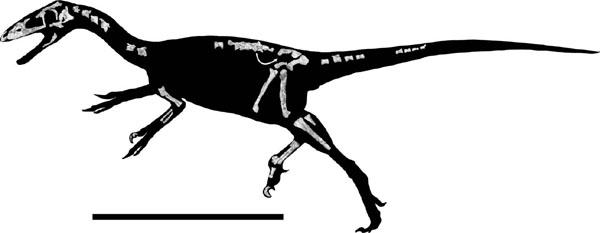The Sino-American field expedition in the Shishugou Formation at the Wucaiwan locality in the Junggar Basin north of the Tian Shan in the Xinjiang Autonomous Region, led by Dr. XU Xing, Institute of Vertebrate Paleontology and Paleoanthropology, Chinese Academy of Sciences, have produced a number of dinosaur fossils, including several species of small- to medium-bodied theropod.
Recently, a new coelurosaurian theropod, Zuolong salleei gen. et sp. nov., from the upper part of the Middle to Upper Jurassic Shishugou Formation, was excavated and reported in the Journal of Vertebrate Paleontology 30 (6).
Zuolong is known from several cranial bones and a disarticulated postcranial skeleton. It has a large, inclined quadrate foramen that extends onto the medial surface of the quadratojugal, an unusually large fovea capitis on the femoral head, and an apomorphically large distal condyle of metatarsal III with a medially projecting flange on the extensor surface. Radiometric dating of the Shishugou Formation constrains the age of the specimen to the beginning of the Late Jurassic (Oxfordian).
"Coelurosaurians older than the Kimmeridgian stage of the Late Jurassic are relatively rare, but new taxa and phylogenetic analysis strongly support initial coelurosaurian diversification by the Middle Jurassic, and the diversification of derived coelurosaurian groups by the earliest Late Jurassic , said the author, Jonah N.
Choiniere, from the Department of Biological Sciences at the George Washington University, A cladistic analysis of Zuolong salleei in a broadly sampled theropod data matrix recovers it as a basal coelurosaur. These data make Zuolong one of the oldest coelurosaur fossils yet known that preserves both cranial and postcranial bones.
"Zuolong adds to the body of knowledge of the morphology of the earliest coelurosaurians. Zuolong is more complete than the Jurassic basal coelurosaur taxa Proceratosaurus, Tanycolagreus, and Coelurus and offers further information about the morphology of the primitive coelurosaurian cranium , said XU Xing, co-author and lead of the excavation team, The character data provided by Zuolong help polarize some characters for the base of Coelurosauria, but more research is needed to consistently recover this group in phylogenetic analyses and to resolve relationships among basal coelurosaurians.
"Coelurosaurians are rare in Jurassic deposits worldwide. The discovery of Zuolong salleei adds to the diversity of theropods present at Wucaiwan. Although predated by Proceratosaurus, and possibly by Anchiornis and several other relatively derived maniraptoran theropods from China, Zuolong salleei is one of the oldest coelurosaurians known from securely dated strata.
The presence of this new taxon indicates that the theropod fauna in the earliest Late Jurassic of China was at least as diverse as that of other Late Jurassic localities, such as the Cleveland-Lloyd Dinosaur Quarry , said James M. Clark, co-author, from the Department of Biological Sciences at the George Washington University.

Fig.1: Skeletal map of Zuolong salleei. Scale bar equals 1 m (Image by Jonah N. Choiniere)
Related News
Photos
More>>trade
market
- Scientists call for enhancing studies on chromosome engineering in plants
- Center for human brain recording opens at the Institute of Biophysics
- Science academy leaders meet to discuss innovation systems in Beijing
- China unveils its first full image of the Moon
- Geographer CHEN Shupeng, 88, passes away





